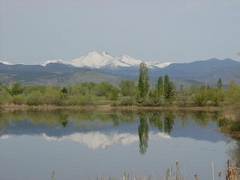
Another dead Plains Cottonwood comes down in the neighborhood, this being the fifth one this year in the vicinity. There are many reasons they are probably planted in residential areas on the Colorado Front Range:
- They grow fast. In our semi-arid climate with a short growing season, they seem like a reasonable choice for those wanting trees quickly.
- They are great shade trees when mature, providing relief from our hot summers and perhaps lowering some utility bills.
- They are native to the area. The pioneers reported that these were the only trees they usually saw on the high plains, always growing next to creeks and rivers. It was a common ritual for homesteaders to periodically gather Cottonwood seedlings from nearby creeks and plant them near their houses, for shade, beauty, and to serve as windbreaks.
A mature Cottonwood, still doing well:

This is not an anti-Cottonwood rant. They are beautiful trees and are an important part of the West. They probably fit in better in their native habitat, along streams and creeks.
Another one in the distance. severely on the downslide:


 One citizen's view of Longmont, Colorado, USA.
One citizen's view of Longmont, Colorado, USA.

No comments:
Post a Comment